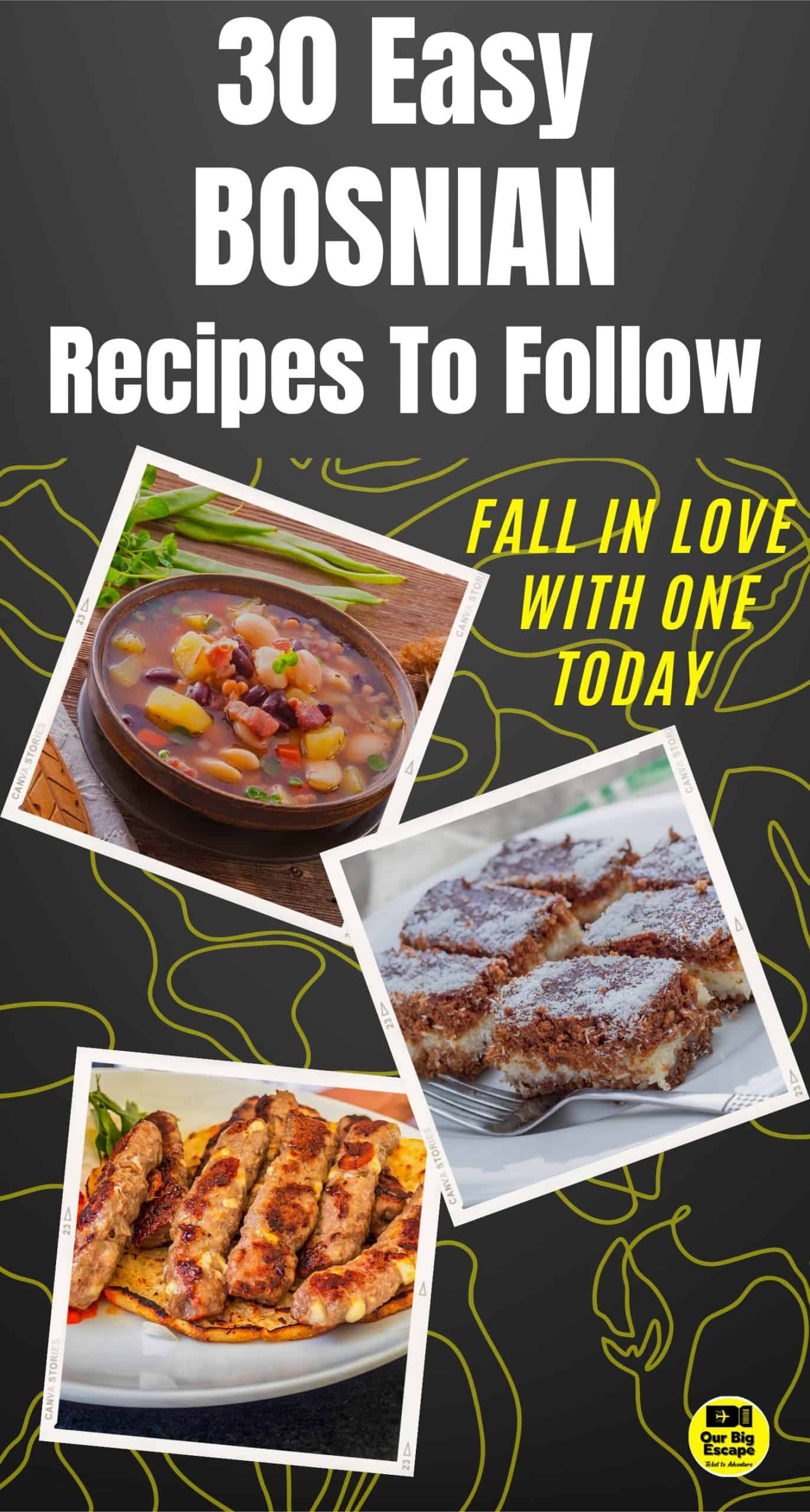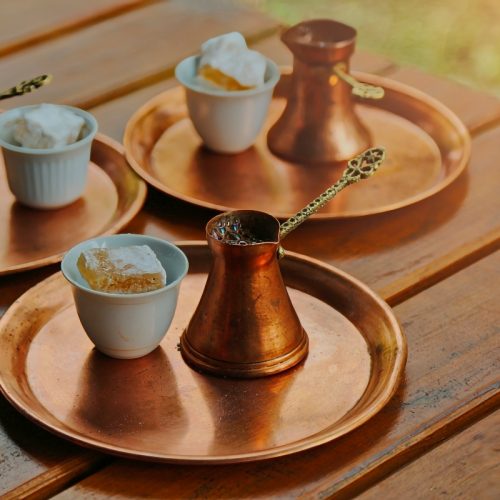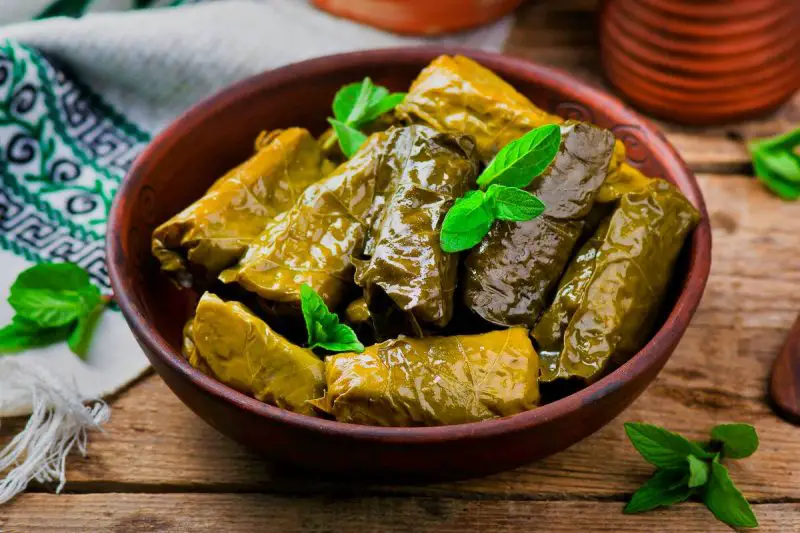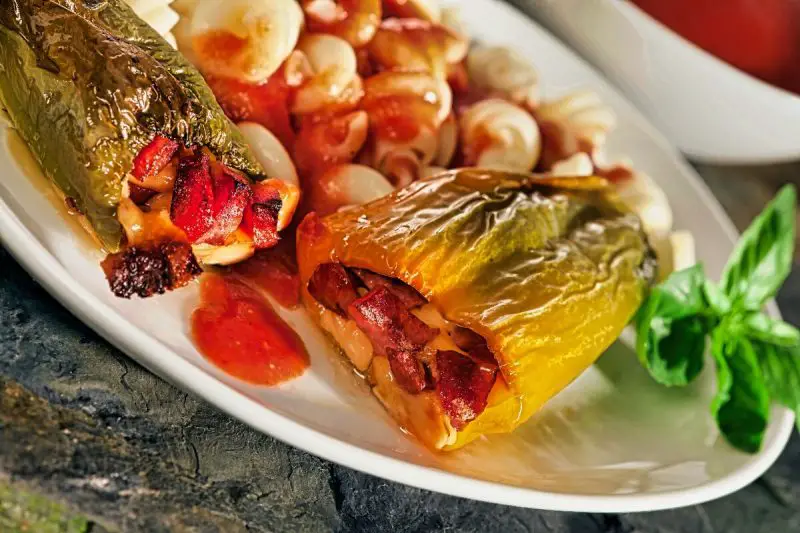
Creating Bosnian Coffee recipes, or Bosnian kahva recipes, is a beloved tradition steeped in Bosnia’s rich history and culture. Bosnian coffee, like Turkish coffee, has a strong, rich taste and a unique preparation process. Bosnian hospitality revolves on sharing a cup of coffee with friends and family and having a heartfelt chat. In this article, we’ll walk you through every step of making Bosnian coffee so you may enjoy it in the comfort of your own home.
Want more ideas to round-out your Bosnian Recipe Box?
A lot of great options are in these posts!
The greatest tasting coffee is made with freshly roasted, high-quality beans. Bosnia Coffee recipes known for their bold flavor, which may be achieved by roasting the beans to a medium-to-dark level. Use a coffee grinder or mortar and pestle to reduce the beans to a fine powder for authentic Bosnian coffee. The coffee grounds should be as finely ground as powdered sugar. Bosnian Coffee recipes are traditionally made in a tiny copper or brass kettle called a dzezva, which has a long handle and a spout with a wide mouth. Cold water should be added to the dzezva, with the quantity determined by the desired serving size. Bear in mind that fildzani, the Bosnian term for coffee cups, are much smaller in diameter than your average espresso cup. Prepare the coffee by measuring out the required quantity of finely ground coffee; each serving will need around one heaping teaspoon.
To preheat the water in the dzezva, set it over low heat on a stovetop or portable burner. Watch the water closely to make sure it doesn’t boil over. Just before the water comes to a full boil, take the dzezva off the heat. Coffee grinds should be added to the dzezva’s hot water shortly after measuring. Let the coffee grinds to float on the surface of the water and form a thick, black coating without stirring the liquid at this time. The coffee mixture should be heated again over low heat in the dzezva, which should be returned to the heat source. Kajmak is the thick froth that forms on the surface of freshly brewed coffee. The idea is to get plenty of froth going without letting the liquid boil over. Carefully take the dzezva away from the fire after the kajmak has formed.
You May Want to Join The World Recipes With Our Big Escape
Share your own recipes in our Facebook Group. Find recipes from all over the world. Learn more about International Cuisine and how you can surprise you family with new and exciting foods from all over the world.
For More Photos Visit Our Instagram at World Recipes Daily – Our Big Escape
Use a tiny spoon to delicately dole out the foam (kajmak) to each fildzani. Carefully pour the coffee from the dzezva into the cups, avoiding the froth. When you sip your Bosnian coffee from a fildzani, the grounds will fall to the bottom. Traditionally, the Bosnian Coffee recipes is accompanied by a glass of water and a sweet treat like sugar cubes, Turkish delight, or baklava. Enjoy the ritual and the coffee’s full taste by taking your time with each sip. Step-by-step instructions for making Bosnian coffee will take you deep into the country’s culture. Bosnian coffee, with its unique preparation process and long history, is more than just a tasty drink; it’s also an experience that draws people together and encourages them to forge lasting bonds.
The Complete Recipe with Ingredients and Step by Step Instructions is Listed Below
3 Reasons People Love the Bosnia Coffee Recipe
1. Rich and Unique Flavor: The Bosnia Coffee recipes is a traditional drink that has a rich and unique flavor. Made with finely ground coffee beans, water, and sugar, it has a bold and robust taste that is different from other types of coffee. The coffee is often served with a cube of Turkish delight or a piece of homemade cake, which enhances its flavor.
2. Ritualistic Experience: Drinking Bosnian Coffee recipes are a ritualistic experience that involves more than just consuming the beverage. It is an opportunity to slow down, relax, and enjoy the company of others. The coffee is served in small, decorative cups, and it is customary to take small sips and enjoy the aroma and flavor of the beverage.
3. Health Benefits: Bosnian Coffee recipe are rich in antioxidants, which have been shown to have numerous health benefits. Drinking coffee has been linked to a reduced risk of several chronic diseases, including type 2 diabetes and liver disease. Additionally, Bosnian coffee is often served with a small amount of sugar, which can help to boost energy levels and improve mood.

How To Make Our Bosnian Coffee Recipe
Ingredients (8 Servings)
8 cups water
8 tbsp finely ground Bosnian coffee
8 tsp sugar
8 cubes of Turkish delight or a piece of homemade cake (optional)
Instructions
1. Add the water to a small pot called a džezva and bring it to a boil.
2. Remove the pot from the heat and let it cool for a minute.
3. Add the coffee and sugar to the pot and stir until combined.
4. Return the pot to the heat and bring it to a simmer over low heat. Be careful not to let it boil.
5. Let the coffee simmer for 3-5 minutes, stirring occasionally.
6. Remove the pot from the heat and let it sit for a minute.
7. Pour the coffee into small, decorative cups, making sure to leave the grounds in the pot.
8. Serve with a cube of Turkish delight or a piece of homemade cake on the side (optional).
Nutritional Information For the Bosnia Coffee recipe
Calories: 2
Carbohydrates: 0g
Protein: 0g
Fat: 0g
Saturated Fat: 0g
Cholesterol: 0mg
Sodium: 0mg
Potassium: 2mg
Fiber: 0g
Sugar: 0g
Prep Time: 5 minutes
Cooking Time: 10 minutes
Pots, Pans, and Cooking Equipment Needed for the Bosnia Coffee Recipe
Džezva (a small pot for brewing Bosnian coffee)
Stovetop or heating source
Small cups for serving
Best Way to Store Leftovers From the Bosnian Coffee Recipe
Bosnian coffee is best served fresh, but if you have leftovers, it can be stored in an airtight container at room temperature for up to 24 hours. It’s not recommended to refrigerate or freeze the coffee, as it can alter the flavor and aroma.
Substitutions For the Bosnia Coffee Recipe
Instead of Bosnian coffee, you can use Turkish coffee or another finely ground coffee.
Instead of sugar, you can use honey, agave nectar, or stevia as a sweetener.
Substitutions For the Vegetarian Bosnian Coffee Recipe
Bosnian coffee is naturally vegetarian, as it only contains water, coffee, and sugar. No animal products are used in the preparation.
Tips and Tricks For Easier Creation
Use freshly roasted and ground coffee for the best flavor.
Let the coffee simmer over low heat to prevent it from boiling, which can cause the coffee to become bitter.
If the coffee tastes too strong, you can dilute it with a small amount of water.
Serve the coffee with a glass of water to cleanse the palate between sips.
Side Dishes and Desserts For the Bosnia Coffee Recipe
Bosnian coffee is often served with a small piece of Turkish delight or homemade cake, which can enhance its flavor. It pairs well with desserts like baklava or simple cookies.
How To Serve the Bosnian Coffee Recipe
To serve Bosnian coffee, pour it into small, decorative cups, making sure to leave the grounds in the pot. It’s customary to take small sips and enjoy the aroma and flavor of the beverage. Serve with a cube of Turkish delight or a piece of homemade cake on the side for a traditional experience. Enjoy!
FAQs About the Bosnia Coffee Recipe
What is Bosnian coffee, and how is it different from regular coffee?
Bosnian coffee is a traditional coffee drink that originated in Bosnia and Herzegovina. It is made by simmering finely ground coffee beans in water and sugar in a small pot called a džezva. It has a bold and robust flavor that is different from other types of coffee.
Can Bosnian Coffee recipes be made with a coffee maker or French press?
No, Bosnian coffee cannot be made with a coffee maker or French press. It requires a special pot called a džezva, which allows the coffee to simmer slowly over low heat.
How is Bosnian coffee served?
Bosnian coffee is served in small, decorative cups, usually with a cube of Turkish delight or a piece of homemade cake on the side. It is customary to take small sips and enjoy the aroma and flavor of the beverage.
What is the best type of coffee to use for Bosnian Coffee recipes?
The best type of coffee to use for Bosnian coffee is finely ground Bosnian coffee beans. The beans are usually roasted and ground locally in Bosnia and Herzegovina.
How do I clean a džezva after making Bosnian coffee?
To clean a džezva after making Bosnian coffee, rinse it with hot water and use a soft brush to remove any coffee residue. Do not use soap or harsh cleaning agents, as they can alter the flavor of the coffee.
Final Thoughts
Being a travel blogger has given me the opportunity to sample a wide variety of coffees from all around the globe. When visiting Bosnia and Herzegovina recently, I was introduced to a traditional Bosnian coffee recipe known as Bosanska kafa, and I have to admit that I am completely smitten with it.
Traditionally, Bosnian coffee is made in a tiny pot called a džezva. Finely ground coffee beans are simmered with water and sugar at low heat to extract maximum flavor. I have never had coffee with such a deep and robust flavor.
Bosnian coffee is my favorite because of the ceremony that surrounds the act of drinking it. It is usual to drink the coffee slowly, savoring the brew’s scent and taste from a tiny, beautiful cup. It’s even better when paired with a sweet treat, such a cube of Turkish delight or a slice of handmade cake.
The Bosnia Coffee recipe ease of preparation is another plus in my book. A džezva, some Bosnian coffee beans, some water, and some sugar are all you need to make this delicious beverage. If you like coffee but are looking for something new, this is a fantastic alternative.
Connecting with the local people and learning about their customs is made easier via sharing a cup of Bosnian coffee, which also has cultural value. In my experience, a terrific way to meet new people and get insight into Bosnian culture is over a cup of Bosnian coffee in a neighborhood café or a friend’s house.
In conclusion, if you get the opportunity to drink some of the Bosnian Coffee recipe, do so. It’s a refreshing drink that’ll set you apart from the crowd. If you give it a try, you could develop a regular appetite for it.
Bosnian Coffee Recipe
Equipment
- Džezva (a small pot for brewing Bosnian coffee)
- Stovetop or heating source
- Small cups for serving
Ingredients
- 8 cups water
- 8 tbsp finely ground Bosnian coffee
- 8 tsp sugar
- 8 cubes of Turkish delight or a piece of homemade cake optional
Instructions
- Add the water to a small pot called a džezva and bring it to a boil.
- Remove the pot from the heat and let it cool for a minute.
- Add the coffee and sugar to the pot and stir until combined.
- Return the pot to the heat and bring it to a simmer over low heat. Be careful not to let it boil.
- Let the coffee simmer for 3-5 minutes, stirring occasionally.
- Remove the pot from the heat and let it sit for a minute.
- Pour the coffee into small, decorative cups, making sure to leave the grounds in the pot.
- Serve with a cube of Turkish delight or a piece of homemade cake on the side (optional).


